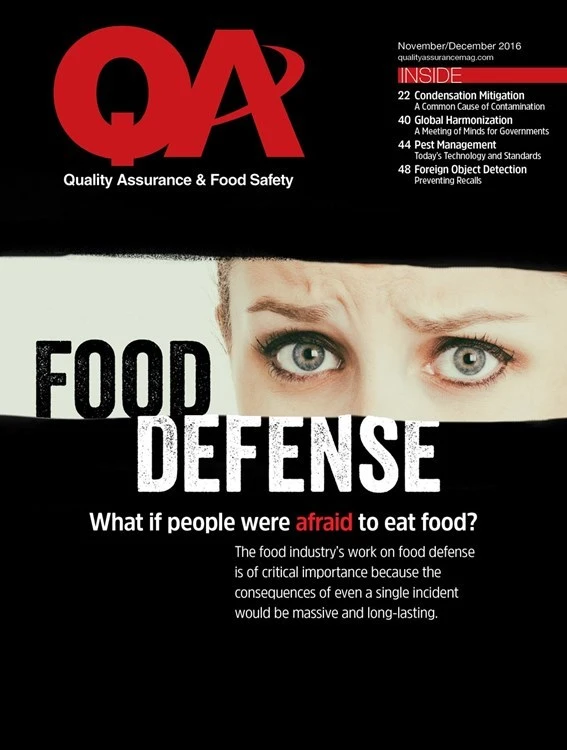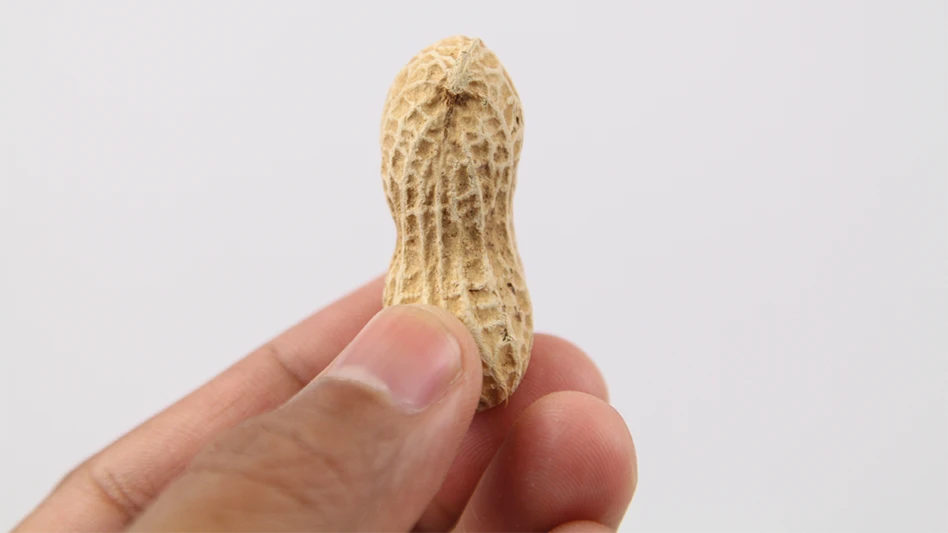
By Lisa Lupo
Whole wheat flour, and apple coffee cakes … 8,000 pounds of ground beef patties, 25,000 pounds of pork product and 200,000 pounds of chicken and beef entrees … 4.6 million pounds of cooked chicken products. These are just a few of the foods that were recalled in 2016 due to “possible foreign matter contamination.”
Best-case outcome is that the food is recalled and the company foots the bill without having had a consumer injured, its brand reputation marred, or its company sued.
But the best case does not always happen. For proof, one simply need read any one of the many such personal injury lawsuits filed in the last year alone — such as the New York chef/restaurateur who paid a $1.3 million fine for a metal wire that a diner swallowed. The wire, that was said to have fallen off a metal brush used to clean the grill, cost the chef a $300,000 award to the diner and $1 million “to warn other restaurants about the practice,” according to Eater New York. Or check out the number of lawyers who specialize in personal injury due to foreign objects in food.
“The United States is a very litigious society and foreign object contamination can lead to many negative outcomes such as lawsuits, bad press toward the company responsible, and costly recalls,” said Detectapro Marketing Manager Paul Gaertner.
Thus, foreign object detection is a critical aspect of a food facility’s food safety plan, to protect both its customers and itself. “First and foremost, the benefit of detection in the food production process is the elimination of foreign object contamination in the final product,” Gaertner said. “Having detection capabilities incorporated in your production line also enhances the company’s standing in procuring business for major franchises. It shows a dedication to a quality program being in place.” In fact, many major food and ingredient buyers require that their suppliers have detection systems in place to ensure the safety of their products.
Two of the most common methods of foreign object detection are the use of inline metal detectors and x-ray systems, with video detection as an up-and-coming method for inspection of incoming goods. Other less common detection applications include such equipment as optical sorting systems, which “sort” out contaminants by detecting objects outside the specified color range, and ultrasound, which detects objects outside the specified composition and physicochemical properties of the food.
With all the various options, how does a management team select the best equipment for its facility?
SELECTING A DETECTION SYSTEM. The factors a food facility should consider in the selection of a system depend on what the facility is producing and what its wants to accomplish, Gaertner said.
Following are a few examples to consider in your selection:
- Quality and safety. X-raydetection has been found to also help in measuring the dimensions of a final product for food quality while also looking for foreign objects for food safety. So a question to be considerred is whether the company has a dedication to sound quality practices that require foreign object detection as a step in the quality process.
- Alarms and sweeper arms. Most metal-detection and x-ray systems have some sort of alarm to alert workers or supervisors that a foreign object has been detected. Some have sweeper arms that automatically remove the product from the line, while others will stop the line and require the reevaluation of an entire batch or lot.
- Inaccessible areas. Intended to be used by a trained inspector who can recognize a problem by making a visual assessment of conditions, illuminated inspection cameras do not have an automated alarm/alert. However, these inspection tools are ideally suited for performing a visual inspection of areas that are difficult or dangerous to access, such as the inside of tanks, hoppers, bulk transportation vehicles, vats, or any confined space, said Zistos President Bob Levine.
“The inspections can be conducted without the complexity of maintaining sanitary conditions when an individual must enter a sanitized vessel to inspect its interior and without the need to perform a dangerous confined space entry,” Levine explained. The systems are capable of revealing contaminants such as vermin, foreign objects, corrosion, residual heel, faulty liners, structural issues, mold, dirt and debris, he said. “Video-based camera inspection systems can be used to perform a fast and safe visual inspection in a food grade vessel to ensure that hygienic conditions exist.”
INTEGRATING MULTIPLE CHECKS. A combination of systems may be valuable depending on the product being produced and what the company is trying to achieve. “In most instances,” Levine said, “a combination of systems would be required to guard against contaminants on a micro and macro level.”
Thus, a manufacturer may have multiple checks with detectors in place throughout the processing line, with a combination of systems that visually look for gross defects or foreign objects in large vessels, along with other technology, such as metal detectors and x-ray systems that look for production line problems on a smaller scale such as metal or glass, or other contaminants.
COST CONSIDERATIONS. It is likely that a facility’s budget also will play a strong role in the selection of a detection system. For example, Gaertner said, a good metal detection head can run $10,000 while an x-ray detection unit can run in excess of $100,000. “If your facility has 30 production lines, it is much more economical to have metal detection units in place than x-ray units,” he said.
But, ultimately, he added, it becomes a company-by-company, facility-by-facility decision based on the needs of the operation, product being produced, and the extent to which the company has quality assurance programs in place.

Human error also needs to be considered in selection, Levine said. “These errors range from the dropping of a foreign object into a vessel to failure to perform a critical wash/sanitization process on a storage or transportation vessel.”
But no matter how many, how few, or what kind of detection systems are put in place, virtually all experts will recommend that one be placed at packaging. As Gaertner said, “Ultimately, a final check at final packaging will reduce foreign object contamination from reaching the end user.”
For video-camera inspection systems, this often means placement just prior to the fill of a food-grade product into a large tank, vat, or bulk transportation vessel. “Large contamination events can be avoided by performing an internal visual inspection of the holding vessel at this stage,” Levine said.
SYSTEM LIMITATIONS. Whether a facility decides to incorporate an x-ray system, metal detection, video cameras, or any other system, it is important that the limitations of each are understood.
For example, the limiting factor in the use of a video-based camera-inspection system is that the defect or contaminant must be visible, Levine said. “The cameras do have an optical-zoom capability that can magnify an image by up to 40 times, but they will not detect microscopic contaminants in a vessel.”
Metal detection and x-ray systems must be calibrated on a regular basis, and each company must calibrate its detectors to the food it is processing, and then set it to a threshold, Gaertner said.
That threshold is determined by such factors as:
- The size of contaminant the facility wants the detector to reject.
- The type of product passing under the detector (dry or wet).
- Product size.
- Product orientation.
- Line speed.
For example, the calibration of a metal detector is tested by passing a known size of ferrous, stainless steel, or nonferrous test sticks or spheres under the unit. “It is critical for the processor to continually check calibration as the same product can possibly give off a different signal due primarily to moisture content of the product,” Gaertner said. “Without continuous calibration, the metal detectors can allow larger pieces of foreign contamination to get through compared to their threshold settings.”
TRAINING AND EDUCATION. Worker education is also a critical factor in ensuring that any type of foreign object detection system works properly. Gaertner noted a situation in which an equipment provider responded to a facility’s service request, only to find that the machine had been turned off. Upon further investigation, it was found that workers had turned off the unit because it was showing too many false positives.
Because the workers did not understand how to calibrate the detection machine, did not know whom to contact in the organization about false positives and calibration, and were being pressured for production, they decided to simply ignore the company’s quality program requirements — allowing for the potential of foreign object contamination in the final product.
In the final decision, Levine said, “Inspection/detection systems should be considered based on their ability to mitigate equipment or human errors that could lead to contamination events.”
Thus, you need to consider any and all potential issues — from foreign objects brought in with incoming goods to mechanical or structural problems in processing and holding equipment to human error or ignorance — that could potentially add contaminants or debris.
The author is Editor of QA magazine. She can be reached at llupo@gie.net.

Explore the December 2016 Issue
Check out more from this issue and find your next story to read.
Latest from Quality Assurance & Food Safety
- AFDO Webinar Series Offers Strategies for Difficult Times
- FDA, USDA Rehire Some Staff, Multiple Sources Report
- Nestlé Opens Arizona Beverage Factory and Distribution Center
- Ingredion Invests $100 Million in Indianapolis Plant to Improve Efficiency, Enable Texture Solutions Growth
- Eagle Unveils Redesigned Pipeline X-ray System
- USDA Invests Up To $1 Billion to Combat Avian Flu, Reduce Egg Prices
- Washington Cats Confirmed with HPAI as Investigation into Contaminated Pet Food Continues
- USDA Confirms Bird Flu Detected in Rats in Riverside





